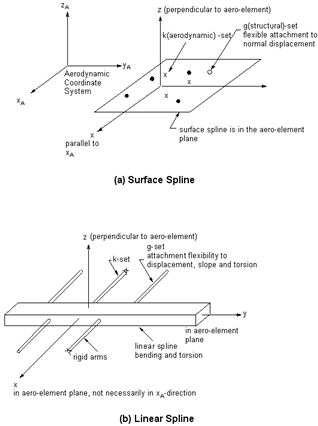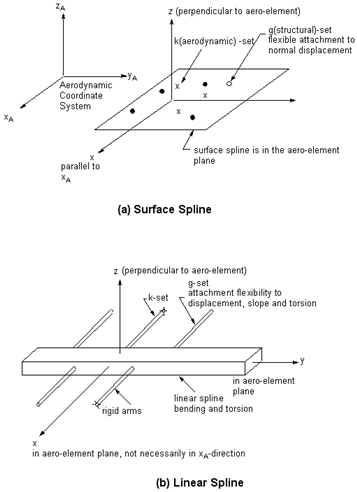XXXXXXXXXXXXXXXXXXXXXXXXXXXXXXXXXXXXXXXXXXXXXXXXXXXXXXXXXXXXXXXXXXXXXXXXXXXXXXXXXXXXXXXXXXXXXXXXXXXXXXXXXXXXXXXXXXXXXXXXXXXXXXXXXXXXXXXXXXXXXXXXXXXXXXXX''"> Guidelines
The interpolation from the structural to aerodynamic degrees of freedom is based upon the theory of splines (
Figure B‑3). High aspect ratio wings, bodies, or other.
Figure B‑3 Splines and Their Coordinate Systems
beam‑like structures should use linear splines (SPLINE2). Low aspect ratio wings, where the structural grid points are distributed over an area, should use surface splines (SPLINE1). Several splines can be used to interpolate to the boxes on a panel or elements on a body; however, each aerodynamic box or element can be referenced by only one spline. Any box or body element not referenced by a spline will be “fixed” and have no motion, and forces on these boxes or elements will not be applied to the structure. A linear relationship (like an MPC) may be specified for any aerodynamic point using the SPLINE3 entry. This is particularly useful for control surface rotations.
For all types of splines, the user must specify the structural degrees of freedom and the aerodynamic points involved. The degrees of freedom utilized at the grid points include only the normal displacements for surface splines. For linear splines, the normal displacement is always used and, by user option, torsional rotations and/or slopes may be included.
The SPLINE1 data entry defines a surface spline This can interpolate for any “rectangular” subarray of boxes on a panel. For example, one spline can be used for the inboard end of a panel and another for the outboard end. The interpolated aerodynamic degrees of freedom (k‑set) are specified by naming the lowest and highest aerodynamic grid point numbers in the area to be splined. A parameter
DZ is used to allow smoothing of the spline fit. If

(the recommended value), the spline will pass through all deflected grid points. If

, then the spline (a plate) is attached to the deflected grid points via springs, which produce a smoother interpolation that does not necessarily pass through any of the points. The flexibility of the springs is proportional to DZ.
Three different methods of surface splines can be invoked with the METH field on the SPLINE1 entry: IPS, TPS and FPS (infinite, thin and finite plate spline, respectively). For the flat plate aerodynamics contained in FLDS, there is little benefit from selecting the TPS. If the TPS is selected and all the grids are coplanar, the algorithm automatically reverts to IPS in any case. The FPS is a recent addition to the arsenal of spline methods in MSC.Nastran and is believed to provide improved performance relative to the two infinite splines since it is better able to handle the deformation patterns at the edge of the aerodynamic panel. It is therefore recommended that the FPS be selected, but that the other two methods are available as a fallback if FPS performance is not satisfactory.
The USAGE flag on the SPLINE1 entry identifies whether the spline is to be used to transform forces, displacements or both (FORCE, DISP or BOTH). The BOTH option is often acceptable, but the other options provide the ability to tailor the splining to the application. Since the force transformation imposes loads on the structure, it is reasonable to select grid points that can withstand this loading without severe deformations. The displacement transformation requires an accurate representation of the overall deformation pattern, so it is quite conceivable that a different set of grids from the force transform would be the most appropriate.
Final inputs on the continuation of the SPLINE1 entry allow the user to define the mesh density in the chordwise and spanwise directions of the underlying aerodynamic panel. The default values should be adequate, but substituting large numbers provides added refinement in making the transformations.
Figure B‑4 Splines and Their Coordinate Systems
The SPLINE2 data entry defines a linear spline. As can be seen from
Figure B‑3, this is a generalization of a simple beam spline to allow for interpolation over an area. It corresponds to the frequently used assumption of the “elastic axis” in which the structure is assumed to twist about the axis such that the airfoil chord perpendicular to the axis behaves as if it were rigid. The portion of a panel to be interpolated and the set of structural points are determined in the similar manner as with SPLINE1. However, a coordinate system must also be supplied to determine the axis of the spline (which is the elastic axis of the virtual beam); a coordinate system with its Y‑axis collinear with the spline axis is required. That coordinate system should be somewhere near the true elastic axis and approximately aligned with it (e.g., swept if the elastic axis is swept). Since the spline has torsion and bending flexibility, the user may specify the ratio DTOR of flexibilities for a wing as a representative value of

; the default value for this ratio is 1.0. The attachment flexibilities,

,

, and

allow for smoothing, but usually all values are taken to be zero; when the attachment flexibilities are taken to be zero, the spline passes through all of the connected grid points and the value of the ratio DTOR has no effect. In the case where the structural model does not have one or both slopes defined, the convention

and/or

is used. When used with bodies, there is no torsion and the spline axis is along the body so that a user input coordinate system is not required.
There are special cases with splines where attachment flexibility is either required or should not be used. The following special cases should be noted:
1. Two or more grid points, when projected onto the plane of the element (or the axis of a body), may have the same location. To avoid a singular interpolation matrix, a positive attachment flexibility must be used (or better yet, only one grid point selected at that location).
2. With linear splines, three deflections with the same spline Y‑coordinate over determine the interpolated deflections since the perpendicular arms are rigid. A positive DZ is needed to make the interpolation matrix nonsingular.
3. With linear splines, two slopes (or twists) at the same Y‑coordinate lead to a singular interpolation matrix. Use

(or

) to allow interpolation.
4. For some modeling techniques, i.e., those which use only displacement degrees of freedom, the rotations of the structural model are constrained to zero to avoid matrix singularities. If a linear spline is used, the rotational constraints should not be enforced to these zero values. When used for panels, negative values of DTHX will disconnect the slope, and negative values of DTHY will disconnect the twist. For bodies, DTHY constrains the slopes since there is no twist degree of freedom for body interpolation.
The USAGE flag on the SPLINE2 entry performs the same function as on the SPLINE1.
The SPLINE4 bulk data entry is very similar to the SPLINE1 entry. The difference is that the SPLINE4 entry invokes a list of aerodynamic elements that are to be included in the spline while the SPLINE1 entry selects the first and last aerodynamic box to be splined and allows the spline algorithm to determine the intermediate box ID’s.
The SPLINE5 bulk data entry is very similar to the SPLINE2 entry. The difference is the use of a list of aerodynamic elements rather than using "first box - last box" logic.


